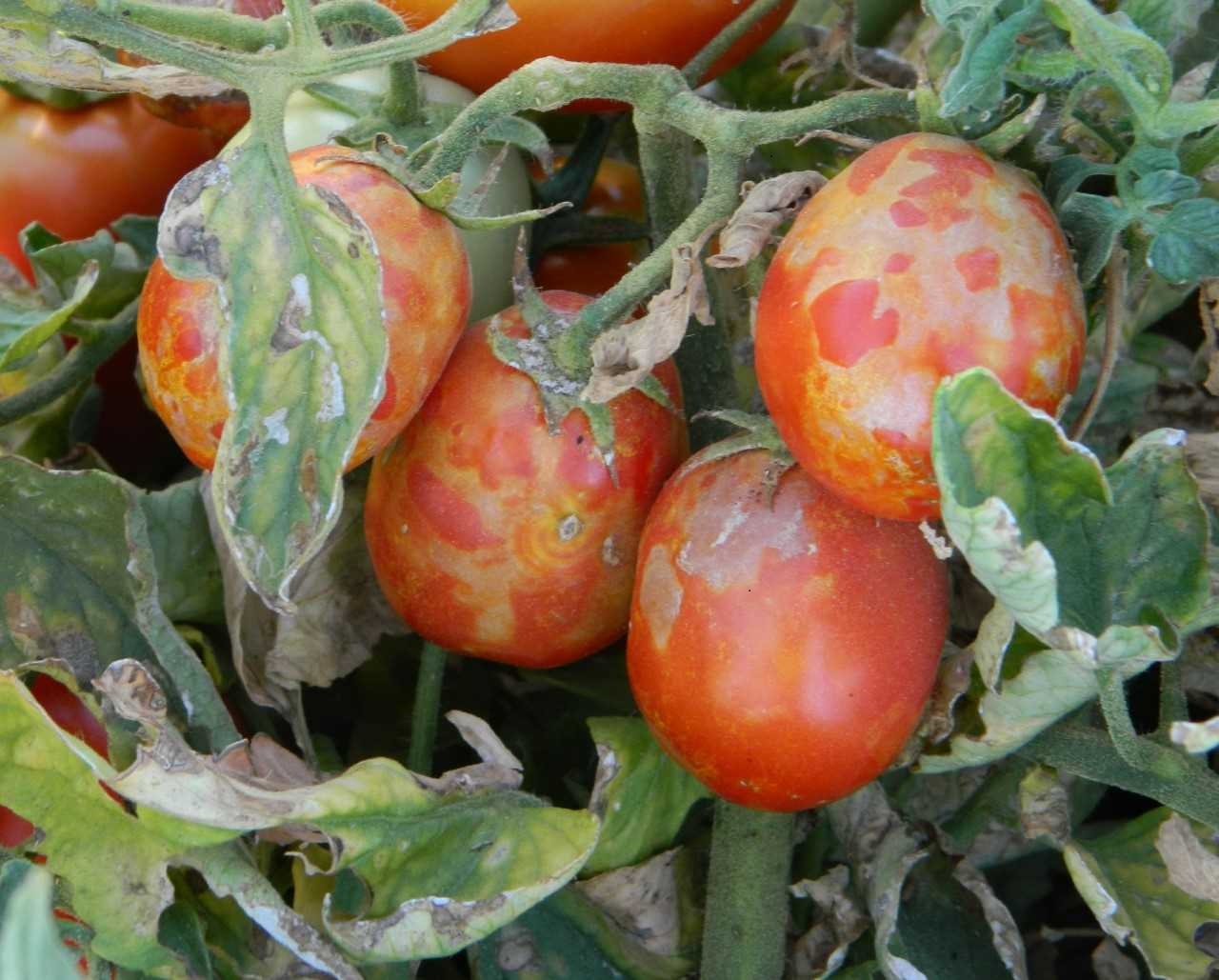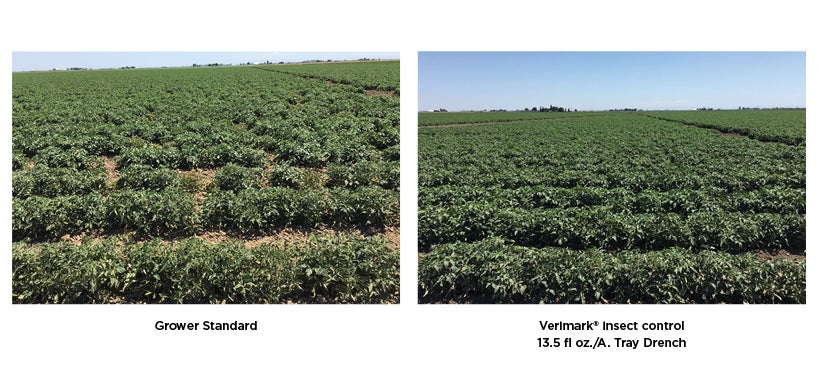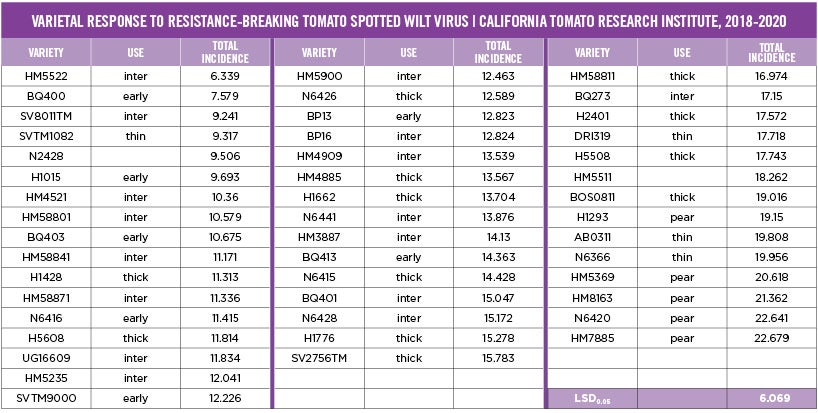Managing TSWV requires multi-pronged approach
California growers can no longer count on tomato varieties with the widely used Sw-5 gene to combat resistance to tomato spotted wilt virus (TSWV). “The resistance-breaking strain of tomato spotted wilt virus (RB-TSWV) is the dominant strain in Central California. The Sw-5 gene is no longer functional in Fresno and Kings counties, which together produce nearly half of California’s processing tomatoes,” says Tom Turini, University of California Extension farm advisor.
First detected in tomatoes in Fresno County in 2016, RB-TSWV has been reported in Fresno, Kings, Merced, Contra Costa and Kern counties. The resistance-breaking strain is present in weeds such as sow thistle and prickly lettuce, and has been detected in California pepper, celery and lettuce fields, providing reservoirs for the inoculum.

TSWV has a broad host range infecting over 1,000 plant species. In tomatoes, it causes plant stunting, necrosis and yellowing of leaves as well as ringspots and necrosis in the fruit. The virus reduces yields and, in fresh markets, the fruit becomes unmarketable. Damage is most severe with early infection. A TSWV outbreak in the mid-2000s caused millions of dollars of losses to California processing tomatoes. Losing cultivar resistance to the virus is a serious blow to the industry.
Researchers have been screening tomato germplasm for new sources of TSWV resistance, but they have not found any that have performed well under the conditions in Central California. That means growers must deploy multiple tactics to manage TSWV and its vector, thrips. “Sanitation, site selection and early management of thrips are necessary components of an IPM program for TSWV,” says Turini. “Insecticides can reduce virus incidence but should not be the sole tactic.”

WESTERN FLOWER THRIPS MANAGEMENT
TSWV is spread from plant to plant by multiple species of thrips, primarily Western flower thrips in California tomatoes. “In order for thrips to transmit the virus as adults, they must acquire it as larvae feeding on infected plants,” says Turini. In the spring, the populations are usually low and gradually build as temperatures increase. With higher temperatures, population densities are usually very high by May, depending upon the season. Virus pressure is typically amplified throughout the season with relatively low pressure in April and May and much higher pressure by August and September.
THRIPS MOVEMENT IN THE LANDSCAPE

“Thrips have a high reproductive rate and short life cycle with multiple generations. Populations build quickly and yield reductions are greatest when the plants are young,” says Turini. “Insecticide applications should target the critical second and third thrips generations to protect early-season tomato plantings and delay infection in late-season plantings.” The UCANR TSWV Field Risk thrips degree-day predictive model can help inform insecticide timing for key production areas.
Several foliar insecticide options are available for thrips management, including Radiant® insecticide (Group 5), Lannate® insecticide (Group 1A) and dimethoate (Group 1B). Turini is conducting thrips efficacy trials with these and other insecticides this season including cyantraniliprole (Group 28) at the highest rate. To minimize the development of insecticide resistance in thrips, growers should rotate insecticide modes of action as indicated by IRAC groups. “With no treatment for TSWV, it’s important to mitigate the thrips. If growers don’t reduce thrips populations early, the virus can quickly get out of control,” says Issa Qandah, FMC technical service manager. “A tray drench application of Verimark® insect control with Cyazypyr® active (Group 28) provides protection to the seedlings when they are most vulnerable. That can be particularly helpful for late-season transplants. Following the insecticide’s 21-28 day residual, growers can rotate to a different IRAC group for foliar applications.”

If Verimark insect control was not applied as a transplant tray drench, Qandah says a foliar application of Exirel® insect control also with Cyazypyr active (Group 28) reduces thrips populations and the ability of adults to lay eggs while having a minimal impact on beneficial insects. It provides long residual activity when used at rates of 16-20 fluid ounces per acre.
TSWV SUPPRESSION IN MERCED CALIFORNIA TOMATO FIELD, 2015

With any foliar insecticide, high water carrier volumes can help improve coverage on the foliage and the flowers where Western flower thrips like to hang out. Early and properly timed insecticide applications can substantially delay the early-season build-up and spread of TSWV that reduces yields of processing tomatoes. That being said, thrips are difficult to control, and cultural practices are critical to minimizing TSWV infection and slowing the development of resistant strains. Below, we outline the recommended IPM approach.
COMPREHENSIVE IPM APPROACH FOR TSWV
Before Planting
- Control weeds in and around tomato fields since many weeds serve as hosts for TSWV, including prickly lettuce, sow thistle and the mustard species.
- Avoid planting tomatoes near inoculum hot spots or fields with bridge crops – mostly lettuce and radicchio –that are TSWV/thrips reservoirs. Don’t put a late-planted field adjacent to an early-planted field.
- Plant TSWV- and thrips-free transplants. Verimark insect control (Group 28) may be applied as a transplant tray drench and offers 21-28 days of residual control of piercing and sucking insects, including leafhoppers, when seedlings are most vulnerable. Neonicotinoid insecticides (Group 4A) are another systemic tray drench option for leafhoppers.
With no effective sources of genetic resistance, it is important to understand the differences in tolerance of current commercial varieties. Check out UC-Davis’ research on which tomato varieties exhibit more tolerance to TSWV in the table below.
View the entire UC-Davis research here
aUTHORED BY t. tURINI, s. Stoddard, R.Gilbertson

During the Growing Season
- If tomatoes are planted near a weedy area, consider treating those weeds with an insecticide before applying a herbicide, discing or mowing because once weeds are destroyed, thrips will move into nearby tomato fields.
- Monitor tomato fields for thrips with yellow sticky cards to assess when thrips populations begin to increase.
- Use the thrips degree-day model on the UCANR TSWV Field Risk Index and Thrips Projections website to learn how thrips populations are developing and when the best time to spray is in different geographies.
- Manage thrips with insecticides at early stages of crop development and when thrips populations begin to increase, typically between the second and third generation.
- Rotate insecticides with different modes of action to minimize development of insecticide resistance in thrips.
After the Growing Season
- Promptly remove and destroy old tomato plants and other host crops after harvest.
- Control weeds and volunteer plants in fallow fields, non-cropped or idle land near next year’s tomato fields.
Much of the work reported on in this article was funded by the California Tomato Research Institute.
Lannate insecticide is a Restricted Use Pesticide. Always read and follow all label directions, precautions and restrictions for use. Some products may not be registered for sale or use in all states. FMC, the FMC logo, Cyazypyr, Exirel and Verimark are trademarks of FMC Corporation or an affiliate. Lannate and Radiant are trademarks of Dow AgroSciences, DuPont or Pioneer and their affiliated companies or respective owners. ©2021 FMC Corporation. All rights reserved. 21-FMC-0740 06/21



